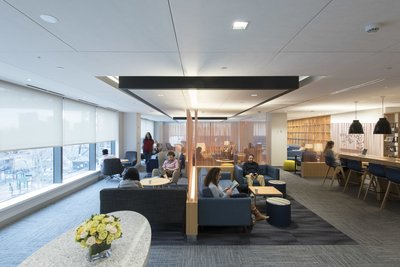The direction of hospital design is taking a turn for the practical as a surge of institutions are updating their infrastructure and responding to demands for more outpatient facilities. Beyond aesthetics, hospitals are seeking architectural updates that improve safety, patient and staff satisfaction, and friendliness to the environment.
Infection control, lighting conditions, noise level, air quality, and patient room design are just some of the factors that are considered. “Preventing infections is probably the most important design feature for patient outcomes—[design aspects] like easy-to-clean rooms and easy access to hand gel dispensers,” said Robert Wachter, MD, professor and chair, Department of Medicine, University of California, San Francisco, School of Medicine. “Additionally, providing space for families to stay comfortably in the room is likely to make a difference.”
Another trend in hospital design is environmentally friendly structures that take into account the evolving nature of health care. A growing use of robotics and more procedures being done at the bedside also are influencing renovations and new construction.
“Preventing infections is probably the most important design feature for patient outcomes—[design aspects] like easy-to-clean rooms and easy access to hand gel dispensers.”
Robert Wachter, MD
University of California, San Francisco, School of Medicine
The University of Alabama at Birmingham (UAB) Health System sought input from staff before building several new facilities. “We also work with our clinical care providers to get their feedback on the design plans to ensure their needs are met,” said Arpan Limdi, chief facilities officer at UAB Medicine.
“Most projects take about 2 to 5 years, but it can take up to 10 years for large complex hospitals,” said Melissa Piatkowski, a research associate with the nonprofit Center for Health Design. New hospital construction costs average $400 a square foot and in New York City rise to about $1,200 a square foot, according to results of a 2016 hospital construction survey published by Health Facilities Management.
The patient experience
In 2016, Memorial Sloan Kettering Cancer Center in New York City opened the Josie Robertson Surgery Center to handle the increasing demand for outpatient cancer procedures. The 16-story, $300-million building on the Upper East Side of Manhattan includes many unique touches that are intended to improve the patient experience. For example, some of the floors feature a figure-eight walking path so that patients don’t have to walk the entire hallway if they’re not able to. Artwork on the walls serves as milestones for patients to show them how far they have walked. All patient rooms are private with their own bathroom. Plus, each room contains video conferencing technology so patients can talk with loved ones.

Keith Horvath, MD, senior director of clinical transformation at the AAMC, noted that care delivery is improved when private rooms accommodate family members. “Information for and input from family members naturally occurs when they are at the bedside rather than sequestered in a waiting room.”
Memorial Sloan Kettering is conducting studies to see how the new design features are affecting patient care, outcomes, and overall satisfaction. “We are very focused on creating a positive patient experience, making sure patients are satisfied with clinical care, but also with every aspect through their journey—from the valet service to operational aspects and experience with the space itself,” said Suzen Heeley, executive director of design and construction at Memorial Sloan Kettering Cancer Center. “As we develop building projects, we are forward-thinking so our facilities are relevant and sustainable for years to come.”
Customizing space for veterans
The U.S. Department of Veterans Affairs (VA) has been replacing some of its aging facilities with 21st-century buildings. In Louisville, Ky., a new health care facility serving veterans will break ground in 2018. With a budget of about $1 billion, Robley Rex VA Medical Center will add a new building with 104 patient beds and nearly 1 million square feet of diagnostic and treatment space, including a 130,000-square-foot regional office.
The project design is still under development with two firms, but it will reflect the special needs of veterans, said Suzanne Harrett, an interior designer for the Veterans Health Administration, who serves on a team that includes a physician, a nurse, and other design professionals. “We need to ensure space is available throughout the facility to accommodate scooters and wheelchairs,” she said. “We will also include a lot of outdoor space to give our patients a place to recuperate—and even provide areas for their animals since many use service dogs on a daily basis.”
A team is looking at ways to improve safety for veterans, too. The strategic location of doorways, handrails, and toilets can help to reduce falls and the seriousness of any injury. In addition, the design team is evaluating various flooring options that can provide a bit more give in case of falls.
Garden and light design
Some hospitals have introduced garden and landscape features where patients can find quieter surroundings and enjoy natural light and fresh air. At one of its new centers, UAB Hospital created a tree-lined retreat for strolling and relaxing.
An essay in The Lancet discussed how hospitals with landscaped gardens are “a restorative resource” that can help patients cope with stress. Additionally, the author noted that having access to gardens generally improves quality of life for patients and encourages walking exercise.
“When there’s light and accessibility to light, patients heal quicker. We wanted the building to treat patients, not just house them.”
Jay Kasey
The Ohio State University
The design team at the James Cancer Hospital at The Ohio State University (OSU) wanted to offer gardens, especially for bone marrow transplant recipients with extended stays, said Jay Kasey, senior vice president of administration and planning at OSU. “The gardens on certain patient floors have trellises and planters with beautiful flowers and vines growing because we have seen how gardens make a positive difference in patient recovery.”
Kasey added that the presence of natural light was another important design feature of the 21-story, 308-bed hospital. Radiation oncology centers are usually located in the basement, but the department is located on the second floor. “When there’s light and accessibility to light, patients heal quicker. We wanted the building to treat patients, not just house them,” said Kasey.
Accommodating staff
With the growing shortage of doctors, nurses, and other health care professionals, some hospitals are conscious of creating facilities that are more efficient and pleasing to staff.
The new Memorial Sloan Kettering space includes an outdoor area on the staff level. This 14th-floor loft gives staff members the chance to step away from work and collect themselves. The space includes a lounge and dining area to spend time alone or catch up with a colleague.
The new VA facility in Kentucky will incorporate public spaces that provide a greater connection to the outdoors and natural light for both the patients and staff members, said H. Lynn Speevack, MD, who serves on the design committee. “We anticipate this will improve morale and the overall experience of our staff.”
The James Cancer Hospital at OSU includes patient floors with quiet, nondistracting spaces where health care teams can meet and debrief after evaluating a patient. Some facilities use glass conference rooms so the team can see patients but have a private area to talk. In some cases, there are alcoves where physicians can chart immediately about the patients’ conditions and capture more accurate information instead of waiting to do a batch of charts at the nurse’s station.
“Over the years we’ve seen so much progress with more hospitals adopting an evidence-based approach that now includes facility design to support outcomes for patients and staff,” Piatkowski summed up. The age of “better healing through better hospital design” has taken off.
